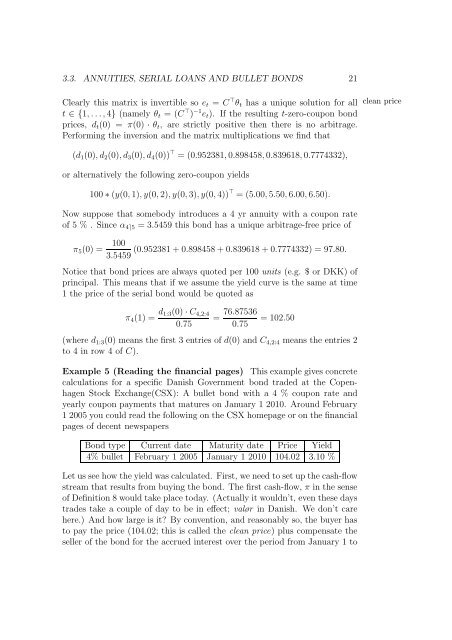Lecture Notes for Finance 1 (and More).
Lecture Notes for Finance 1 (and More).
Lecture Notes for Finance 1 (and More).
You also want an ePaper? Increase the reach of your titles
YUMPU automatically turns print PDFs into web optimized ePapers that Google loves.
3.3. ANNUITIES, SERIAL LOANS AND BULLET BONDS 21<br />
Clearly this matrix is invertible so et = C ⊤ θt has a unique solution <strong>for</strong> all<br />
t ∈ {1, . . ., 4} (namely θt = (C ⊤ ) −1 et). If the resulting t-zero-coupon bond<br />
prices, dt(0) = π(0) · θt, are strictly positive then there is no arbitrage.<br />
Per<strong>for</strong>ming the inversion <strong>and</strong> the matrix multiplications we find that<br />
(d1(0), d2(0), d3(0), d4(0)) ⊤ = (0.952381, 0.898458, 0.839618, 0.7774332),<br />
or alternatively the following zero-coupon yields<br />
100 ∗ (y(0, 1), y(0, 2), y(0, 3), y(0, 4)) ⊤ = (5.00, 5.50, 6.00, 6.50).<br />
Now suppose that somebody introduces a 4 yr annuity with a coupon rate<br />
of 5 % . Since α4⌉5 = 3.5459 this bond has a unique arbitrage-free price of<br />
π5(0) = 100<br />
(0.952381 + 0.898458 + 0.839618 + 0.7774332) = 97.80.<br />
3.5459<br />
Notice that bond prices are always quoted per 100 units (e.g. $ or DKK) of<br />
principal. This means that if we assume the yield curve is the same at time<br />
1 the price of the serial bond would be quoted as<br />
π4(1) = d1:3(0) · C4,2:4<br />
0.75<br />
= 76.87536<br />
0.75<br />
= 102.50<br />
(where d1:3(0) means the first 3 entries of d(0) <strong>and</strong> C4,2:4 means the entries 2<br />
to 4 in row 4 of C).<br />
Example 5 (Reading the financial pages) This example gives concrete<br />
calculations <strong>for</strong> a specific Danish Government bond traded at the Copenhagen<br />
Stock Exchange(CSX): A bullet bond with a 4 % coupon rate <strong>and</strong><br />
yearly coupon payments that matures on January 1 2010. Around February<br />
1 2005 you could read the following on the CSX homepage or on the financial<br />
pages of decent newspapers<br />
Bond type Current date Maturity date Price Yield<br />
4% bullet February 1 2005 January 1 2010 104.02 3.10 %<br />
Let us see how the yield was calculated. First, we need to set up the cash-flow<br />
stream that results from buying the bond. The first cash-flow, π in the sense<br />
of Definition 8 would take place today. (Actually it wouldn’t, even these days<br />
trades take a couple of day to be in effect; valør in Danish. We don’t care<br />
here.) And how large is it? By convention, <strong>and</strong> reasonably so, the buyer has<br />
to pay the price (104.02; this is called the clean price) plus compensate the<br />
seller of the bond <strong>for</strong> the accrued interest over the period from January 1 to<br />
clean price

















